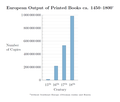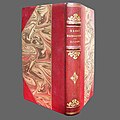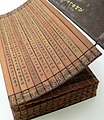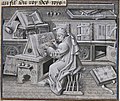Portal:Books
Portal maintenance status: (April 2020)
automated editing software. Learn how to update the maintenance information here . |
The Books Portal
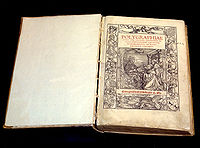
A book is a medium for recording information in the form of writing or images. Books are typically composed of many pages, bound together and protected by a cover. Modern bound books were preceded by many other written mediums, such as the codex and the scroll. The book publishing process is the series of steps involved in their creation and dissemination.
As a conceptual object, a book typically refers to a written work of substantial length, which may be distributed either physically or in digital forms like ebooks. These works are broadly classified into fiction (containing imaginary content) and non-fiction (containing content representing truths). Many smaller categories exist within these, such as children's literature meant to match the reading level and interests of children, or reference works that gather collections of non-fiction. Books are traded at both regular stores and specialized bookstores, and people can borrow them from libraries. The reception of books has led to a number of social consequences, including censorship.
A physical book does not need to contain written works: for example, it may contain only drawings, engravings, photographs, puzzles, or removable content like paper dolls. Physical books may be left empty to be used for writing or drawing, such as account books, appointment books, autograph books, notebooks, diaries and sketchbooks.
The contemporary book industry has seen several major changes due to new technologies. In some markets, the sale of printed books has decreased due to the increased use of eBooks. However, printed books still largely outsell eBooks, and many people have a preference for print. The 21st century has also seen a rapid rise in the popularity of audiobooks, which are recordings of books being read aloud. Additionally, awareness of the needs of people who can't access print media due to limitations like visual impairment has led to a rise in formats designed for greater accessibility, such as braille printing or formats supporting text-to-voice. Google Books estimated that as of 2010, approximately 130,000,000 unique books had been published. (Full article...)
Featured articles - load new batch
-
Image 1social injustice. The first such book was the Belgian Frans Masereel's 25 Images of a Man's Passion, published in 1918. The German Otto Nückel and other artists followed Masereel's example. Lynd Ward brought the genre to the United States in 1929 when he produced Gods' Man, which inspired other American wordless novels and a parody in 1930 by cartoonist Milt Gross with He Done Her Wrong. Following an early-1930s peak in production and popularity, the genre waned in the face of competition from sound films and anti-socialist censorship in Nazi Germany and the US. (Full article...)
-
Image 2Nigel, the Bishop of Ely from 1133 to 1169, and his disputes with King Stephen. Other themes include the miracles worked by the monastery's patron saint, Æthelthryth, and gifts of land to Ely. (Full article...)Image 3marine biologist Ed Ricketts. It is regarded as one of Steinbeck's most important works of non-fiction chiefly because of the involvement of Ricketts, who shaped Steinbeck's thinking and provided the prototype for many of the pivotal characters in his fiction, and the insights it gives into the philosophies of the two men.)
The Log from the Sea of Cortez is the narrative portion of an earlier work, Sea of Cortez: A Leisurely Journal of Travel and Research, which was published by Steinbeck and Ricketts shortly after their return from the Gulf of California, and combined the journals of the collecting expedition, reworked by Steinbeck, with Ricketts' species catalogue. After Ricketts' death in 1948, Steinbeck dropped the species catalogue from the earlier work and republished it with a eulogy to his friend added as a foreword. (Full article...Image 4rake is brought to repentance and reform by the ruses of his wife, while in The Relapse, the rake succumbs again to temptation and has a new love affair. His virtuous wife is also subjected to a determined seduction attempt, and resists with difficulty. (Full article...)Image 5classification system based on anatomical features, and a dichotomous key to help readers identify birds. This was followed by other English-language ornithologies, notably John Gould's five-volume Birds of Europe published between 1832 and 1837. Sharpe, then librarian of the Zoological Society of London, had worked closely with Gould and wanted to expand on his work by including all species reliably recorded in Europe, North Africa, parts of the Middle East and the Atlantic archipelagos of Madeira, the Canary Islands and the Azores. He lacked the resources to undertake this task on his own, so he proposed to Dresser that they work together on this encyclopaedia, using Dresser's extensive collection of birds and their eggs and network of contacts. (Full article...)Image 6Adoptionist Christology, in which Jesus is chosen to be God's Son at the time of his Baptism; the abolition of the Jewish sacrifices by Jesus; and an advocacy of vegetarianism. (Full article...)Image 7St. Petersburg Times classed it as among the "most interesting and unique cookbooks" published, the Pittsburgh Post-Gazette highlighted it in the article "Favorite Cookbooks for 2002" and The Denver Post included it in a list of best cookbooks of 2002. A review in the Toronto Star criticized Perry's lack of creativity in her choice of recipes. Recipes from the work have been featured in related cookbooks. (Full article...)Image 8Frederick Warne & Co for the 1906 Christmas season. Potter was born in London in 1866, and between 1902 and 1905 published a series of small-format children's books with Warne. In 1906, she experimented with an atypical panorama design for Miss Moppet, which booksellers disliked; the story was reprinted in 1916 in small book format.)
Miss Moppet, the story's eponymous main character, is a kitten teased by a mouse. While pursuing him she bumps her head on a cupboard. She then wraps a duster about her head, and sits before the fire "looking very ill". The curious mouse creeps closer, is captured, "and because the Mouse has teased Miss Moppet—Miss Moppet thinks she will tease the Mouse; which is not at all nice of Miss Moppet". She ties him up in the duster and tosses him about. However, the mouse makes his escape, and once safely out of reach, dances a jig atop the cupboard. (Full article...Image 9The Heart of a Woman (1981) is an autobiography by American writer Maya Angelou. The book is the fourth installment in Angelou's series of seven autobiographies. The Heart of a Woman recounts events in Angelou's life between 1957 and 1962 and follows her travels to California, New York City, Cairo, and Ghana as she raises her teenage son, becomes a published author, becomes active in the civil rights movement, and becomes romantically involved with a South African anti-apartheid fighter. One of the most important themes of The Heart of a Woman is motherhood, as Angelou continues to raise her son. The book ends with her son leaving for college and Angelou looking forward to newfound independence and freedom.
Like Angelou's previous volumes, the book has been described as autobiographical fiction, though most critics, as well as Angelou, have characterized it as autobiography. Although most critics consider Angelou's first autobiography I Know Why the Caged Bird Sings more favorably, The Heart of a Woman has received positive reviews. It was chosen as an Oprah's Book Club selection in 1997. (Full article...)Image 10Plate 21 depicting a male red-capped parrakeet
Illustrations of the Family of Psittacidae, or Parrots is an 1832 book containing 42 hand-coloured lithographs by Edward Lear. He produced 175 copies for sale to subscribers as a part-publication, which were later bound as a book. Lear started painting parrots in 1830 when he was 18 years old, and to get material for his book he studied live birds at the London Zoo and in private collections. The latter included those of Edward Smith Stanley, later 13th Earl of Derby, who had a large menagerie at Knowsley Hall, and Benjamin Leadbeater, a taxidermist and trader in specimens. Lear drew onto lithographic plates for printing by Charles Joseph Hullmandel, who was known for the quality of his reproductions of fine art.
Although the book was a financial failure, Lear's paintings of parrots established his reputation as one of the best natural history artists of his time. It found him work with John Gould, Stanley and other leading contemporary naturalists, and the young Queen Victoria engaged him to help her with her painting technique. Parrots was a forerunner to the major volumes of bird paintings by Gould, and Lear's work has influenced children's illustrators such as Beatrix Potter and Maurice Sendak as well as bird specialists like William T. Cooper, Elizabeth Butterworth and Walton Ford. (Full article...)Image 11Sjair Abdoel Moeloek, it tells of a woman who passes as a man to free her husband from the Sultan of Hindustan, who had captured him in an assault on their kingdom.)
Written over a period of several years and influenced by European literature, Siti Akbari differs from earlier syairs in its use of suspense and emphasis on prose rather than form. It also incorporates European realist views to expand upon the genre, although it maintains several of the hallmarks of traditional syairs. Critical views have emphasised various aspects of its story, finding in the work an increased empathy for women's thoughts and feelings, a call for a unifying language in the Dutch East Indies (now Indonesia), and a polemic regarding the relation between tradition and modernity. (Full article...Image 12Potomac Highlands region, and the organization greatly influenced trends of thought in the Romney community and surrounding areas. (Full article...)Image 13Leslie R. Groves, Jr., the director of the Manhattan Project. The Smyth Report was the first official account of the development of the atomic bombs and the basic physical processes behind them. It also served as an indication as to what information was declassified; anything in the Smyth Report could be discussed openly. For this reason, the Smyth Report focused heavily on information, such as basic nuclear physics, which was either already widely known in the scientific community or easily deducible by a competent scientist, and omitted details about chemistry, metallurgy, and ordnance. This would ultimately give a false impression that the Manhattan Project was all about physics. (Full article...)Image 14Advanced Dungeons & Dragons role-playing game written by Gary Gygax. While Dungeons & Dragons (D&D) is typically a fantasy game, the adventure includes elements of science fiction, and thus belongs to the science fantasy genre. It takes place on a downed spaceship; the ship's crew has died of an unspecified disease, but functioning robots and strange creatures still inhabit the ship. The player characters fight monsters and robots, and gather the futuristic weapons and colored access cards that are necessary for advancing the story.)
Expedition to the Barrier Peaks was first played at the Origins II convention in 1976, where it was used to introduce Dungeons & Dragons players to the science fiction game Metamorphosis Alpha. In 1980, TSR published the adventure, updated for first edition Advanced Dungeons & Dragons rules. The adventure was not updated for later rules systems, but a Wizards.com article did provide a conversion to Future Tech. It included a separate booklet of illustrations, in both color and black and white. The adventure is an old-time favorite of many Dungeons & Dragons fans, including Stephen Colbert. It was ranked the fifth-best Dungeons & Dragons adventure of all time by Dungeon magazine in 2004, and received positive reviews from White Dwarf and The Space Gamer magazines. The other adventures in the S series include S1 Tomb of Horrors, S2 White Plume Mountain, and S4 The Lost Caverns of Tsojcanth. (Full article...Image 15Caesar's invasions of Britain). In one case, the Chronicle was still being actively updated in 1154. (Full article...)Selected picture

Plates vi & vii of the Edwin Smith Papyrus at the Rare Book Room, New York Academy of Medicine. Credit: author unknown
Thetrauma surgery, written in hieratic around the 19th century BC, but thought to be based on material from a thousand years earlier. It is the world's earliest known example of medical literature.More Did you know (auto generated)

- ... that the short story collection Drinking Coffee Elsewhere was chosen by John Updike as a selection for the Today Show book club on NBC?
- ... that Cara De Silva described a cookbook compiled by a woman in Terezin concentration camp as a record of "psychological resistance”?
- ... that the non-fiction book Corvus: A Life with Birds focuses on a rook named after a drag queen called "Madame Chickeboumskaya"?
- ... that Seattle-based Tom Alberg, one of the earliest investors in Amazon, was convinced of the company's promise when he could not find a book by Peter Drucker in his local bookstore?
- ... that Olive MacLeod journeyed 6,000 km (3,700 mi) through Africa in 1910–1911 to visit her murdered fiancé's grave, and wrote a book based on her observations?
- ... that David Dayen, executive editor of The American Prospect, argues in his 2020 book that monopolies are so interwoven with our lives that it is impossible to escape them?
Books topics
- For a topical guide of this subject, see Outline of books
Select [►] to view subcategories
Production Consumption By country Other - Genres
- Grimoire
- Formats
- Coffee table book
Related Related portals
 Good article - load new batchThis is aGood article, an article that meets a core set of high editorial standards.
Good article - load new batchThis is aGood article, an article that meets a core set of high editorial standards.
-
Image 1DuPont over factual inaccuracies contained in the text. In 1968 Lundberg published The Rich and the Super-Rich, described by some sources as a sequel to America's 60 Families. (Full article...)
-
Image 2Pulitzer Prize for General Non-Fiction. In 2012, it was adapted into a documentary film of the same name for PBS. (Full article...)
-
Image 3United States's involvement in the Vietnam War. Powell converted to Anglicanism in 1976 and later attempted to have the book removed from circulation. However, the copyright belonged to the publisher, who continued circulation until the company was acquired in 1991. Its legality has been questioned in several jurisdictions. (Full article...)Image 4Choice: Current Reviews for Academic Libraries, although the latter criticised it for not including bibliographical aids. The authors of the bibliographical work Information Sources of Political Science described it as a "handy guide", and it was used as a reference in Third Force Politics: Liberal Democrats at the Grassroots. (Full article...)Image 5

An example of a page from the Orkneyinga saga, as it appears in a printed copy of the 14th-century Flateyjarbók.
The Orkneyinga saga (Old Norse: [ˈorknˌœyjeŋɡɑ ˈsɑɣɑ]; also called the History of the Earls of Orkney and Jarls' Saga) is a narrative of the history of the Orkney and Shetland islands and their relationship with other local polities, particularly Norway and Scotland. The saga has "no parallel in the social and literary record of Scotland" and is "the only medieval chronicle to have Orkney as the central place of action". The main focus of the work is the line of jarls who ruled the Earldom of Orkney, which constituted the Norðreyjar or Northern Isles of Orkney and Shetland and there are frequent references to both archipelagoes throughout.
The narrative commences with a brief mythical ancestry tale and then proceeds to outline the Norse take-over of the Norðreyjar by Harald Fairhair – the take-over is not in doubt although the role of the king is no longer accepted by historians as a likelihood. The saga then outlines, with varying degrees of detail, the lives and times of the many jarls who ruled the islands between the 9th and 13th centuries. The extent to which the earlier sections in particular can be considered genuine history rather than fiction has been much debated by scholars. (Full article...)Image 6Chicago Historical Society. It exists in both a hardcover print edition and an online format, known as the Electronic Encyclopedia of Chicago. The print edition is 1117 pages and includes 1400 entries, 2000 biographical sketches, 250 significant business enterprise descriptions, and hundreds of maps. Initially, the internet edition included 1766 entries, 1000 more images and sources.)
The concept was fueled by other regional encyclopedias that had met with commercial success in 1980s and 1990s. Eventually, the vision to create the book found initial financing from the National Endowment for the Humanities. The book was well received and became a bestseller during the 2004 Christmas season following its October 2004 release. In May, 2005, the Electronic Encyclopedia of Chicago was released. Northwestern University joined the Newberry Library/Chicago Historical Society collaboration to publish the internet edition. The internet edition was the second of its kind for a U.S. city. (Full article...Image 7William George Hoskins. The book is also the introductory volume in a series of the same name which deals with the English Landscape county by county.)
It is illustrated with 82 monochrome plates, mostly photographs by Hoskins himself, and 17 maps or plans. It has appeared in at least 35 editions and reprints in English and other languages. (Full article...Image 8Guru Dutt: An Unfinished Story is a 2021 Indian biographical book written by Yasser Usman, chronicling the life and career of the Indian actor and filmmaker Guru Dutt. It describes Dutt's birth in Panambur in 1925, his 18-year-long film career, his marriage to the playback singer Geeta Dutt, with whom he had three children, and his death in 1964.
The book was written by Usman in the period of two years. He collected archives of Dutt's accounts and information from Dutt's family members, close friends, and colleagues, compiling them in a book that was later published on 7 January 2021 by Simon & Schuster. It received positive feedback from critics, with most attention directed towards Usman's writing. (Full article...)Image 9Creek leader Alexander McGillivray, Thomas Jefferson and James Madison's founding of the Democratic-Republican Party, and the Louisiana Purchase.)
Ellis, who had previously won the National Book Award and the Pulitzer Prize for History, wanted to write a book portraying the Founders neither as demigods nor villains, but as flawed men who were improvising in response to immediate crises. The book reached #4 on The New York Times Best Seller list, and received largely positive reviews from critics. (Full article...Image 10
Hellenic Nomarchy (Greek: Ελληνική Νομαρχία The Greek rule of law) was a pamphlet written by "an Anonymous Greek" published and printed in Italy in 1806. It advocated the ideals of freedom, social justice and social equality as the main principles of a well-governed society, making it the most important theoretical monument of Greek republicanism. Its author, arguing for both social autonomy and national sovereignty, supported the Greek struggle for national liberation and turned to the moral greatness of ancient Greece in order to stimulate collective pride. Although this work was widely read by Greeks before the outbreak of the Greek War of Independence in 1821, from its first appearance it was received with discomfort by its contemporary audience, and later generated scholarly debates on the identity of its author. (Full article...)Image 11The Fate of Fausto: A Painted Fable is a 2019 children's picture book written and illustrated by Oliver Jeffers. Inspired by the German legend of Faust, the book follows the arrogant titular character Fausto, who wants to own every natural worldly possession. It addresses themes of greed, colonialism, power, and environmentalism.
The pages were illustrated using traditional lithographic printmaking techniques, making use of coloured-pencil style figures and saturated shades over expanses of white spaces. Reviewers praised the book for its sparse narrative, illustrations and appeal to the audience. The book featured on the year-end lists by publications such as The Guardian and Time. (Full article...)Image 12philologist. It has been compared to the poetic works of George Sterling and Kenneth Patchen.)
The book was published during the height of the nature fakers controversy, and it has been suggested that De Esque elected to release Betelguese, a Trip Through Hell while Theodore Roosevelt was on a trip to Africa in an effort to avoid potential conflict that might have resulted from Roosevelt's awareness of its content. (Full article...Image 13This Is Not My Hat is a 2012 American children's picture book by the author and illustrator Jon Klassen. The story is told through the unreliable narration of a little fish, who has stolen a hat from a big fish and how the big fish reacts to the theft. It is a thematic follow-up to I Want My Hat Back (2011) and was meant to be a more literal sequel until Klassen took a suggestion to change which animals were in the story. The book was well received by critics who praised its dark or ironic humor which could only be understood by comparing the words of the little fish's narration against the events of the illustrations. In addition to several positive reviews, Klassen received the 2013 Caldecott Medal and the 2014 Kate Greenaway Medal becoming the first book to win both awards. This is Not My Hat was also a commercial success. (Full article...)Image 14Banglapedia: the National Encyclopedia of Bangladesh is the first Bangladeshi encyclopedia. It is available in print, CD-ROM format and online, in both Bengali and English. The print version comprises fourteen 500-page volumes. The first edition was published in January 2003 in ten volumes by the Asiatic Society of Bangladesh, with a plan to update it every two years. The second edition was issued in 2012 in fourteen volumes.
Banglapedia was not designed as a general encyclopedia but as a specialized encyclopedia on Bangladesh-related topics. For the encyclopedia's purposes, Bangladesh is defined as the territory comprising ancient Eastern India, Bengal Sultanate, Bengal Subah, Bengal Presidency, East Bengal, East Pakistan, and the independent Bangladesh, in historical succession. (Full article...)Image 15freedom of speech in the United States written by Michael Kent Curtis and published in 2000 by Duke University Press. The book discusses the evolution of free speech in the U.S. within the context of the actions of individuals and how they affected change. The author writes that protests and actions by citizens helped to evolve the notions surrounding free speech in the U.S. before definitive statements on the matter from U.S. courts. Curtis writes that free speech rights were first developed in "the forum of public opinion", and that, "The history of free speech shows the need for broadly protective free speech rules applied generally and equally".)
For his work on Free Speech, "The People's Darling Privilege", Curtis received the Hugh M. Hefner First Amendment Award and the Mayflower Cup Award. Critics gave the book a positive reception. A review in Columbia Journalism Review called it a "rich and original study", and The Journal of American History said that it includes "fine analytic discussions". Perspectives on Political Science called the book "an extremely valuable contribution to the literature addressing the history of free speech in America." Timothy C. Shiell of the University of Wisconsin–Stout reviewed it for The Historian and wrote, "Michael Kent Curtis offers a major contribution to the scholarship of both that era and of free speech." (Full article...Selected quote

“ Some books are to be tasted, others to be swallowed, and some few to be chewed and digested. ” — Francis Bacon Did you know
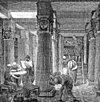
- ...that Library of Alexandria was once the largest library in the world?(Pictured)
- ...that the government of Bavaria, in agreement with the federal government of Germany, does not allow any copying or printing of Mein Kampf in Germany?
- ...that among the books that end up in the Simpson's fireplace in episode Dog of Death are The Lottery by Shirley Jackson, Fahrenheit 451 by Ray Bradbury (which ironically enough, is about a society where books are burned),and Fatherhood by Bill Cosby?
General images
The following are images from various book-related articles on Wikipedia.)-
Image 1European output of printed books c. 1450–1800 (from History of books)
-
Image 3Decorative binding with figurehead of the 12th century manuscriptLiber Landavensis (from Bookbinding)
-
Image 4Hardbound book with half leather binding (spine and corners) and marbled boards (from Bookbinding)
-
Image 5European output of manuscripts 500–1500 (from History of books)
-
Image 6Woman holding wax tablets in the form of the codex. Wall painting from Pompeii, before 79 CE. (from History of books)
-
Image 7The scene in Botticelli's Madonna of the Book (1480) reflects the presence of books in the houses of richer people in his time. (from History of books)
-
Image 8A Chinese bamboo book (from History of books)
-
Image 9Three books with different titling orientations:
(left) ascending
(middle) descending
(right) upright (from Bookbinding) -
Image 10European output of books 500–1800 (from History of books)
-
Image 11Traditionally sewn book opened flat (from Bookbinding)
-
Image 1212-metre-high (40 ft) stack of books sculpture at the Berlin Walk of Ideas, commemorating the invention of modern book printing (from History of books)
-
Image 13Early medieval bookcase containing about ten codices depicted in the Codex Amiatinus (c. 700) (from Bookbinding)
-
Image 14AOriental Institute at the University of Chicago, inscribed with the text of the poem Inanna and Ebih by the priestess Enheduanna, the first author whose name is known
-
Image 16Thespine of the book is an important aspect in book design, especially in the cover design. When the books are stacked up or stored in a shelf, the details on the spine is the only visible surface that contains the information about the book. In a book store, it is often the details on the spine that attract the attention first. (from Book design)
-
Image 17Folio from the Shah Jahan Album, c. 1620, depicting the Mughal Emperor Shah Jahan (from History of books)
-
Image 18A 15th-century Incunable. Notice the blind-tooled cover, corner bosses, and clasps. (from History of books)
-
Image 20Hardbound book spine stitching (from Bookbinding)
-
Image 21Modern book spine designs (from Bookbinding)
-
Image 22Page from a Jain manuscript depicting the birth of Mahavira, c. 1400 (from History of books)
-
Image 23A traditional bookbinder at work (from Bookbinding)
-
Image 24Rebacking saving original spine, showing one volume finished and one untouched (from Bookbinding)
-
Image 25An author portrait of Jean Miélot writing his compilation of the Miracles of Our Lady, one of his many popular works. (from History of books)
-
Image 26Scheme of common(from Bookbinding
Image 27Sammelband of three alchemical treatises, bound in Strasbourg by Samuel Emmel c. 1568, showing metal clasps and leather covering of boards (from Bookbinding)Image 28Page from the Blue Quran manuscript, ca. 9th or 10th century CE (from History of books)Image 29Jikji, Selected Teachings of Buddhist Sages and Seon Masters, the earliest known book printed with movable metal type, 1377.Bibliothèque Nationale de France, Paris. (from History of books)Image 30Photograph of a printing press in Egypt, c. 1922 (from History of books)Image 32Book conservators at the State Library of New South Wales, 1943 (from Bookbinding)Image 34Bookbinder's type holder (from Bookbinding)Image 35Page spread with J. A. van de Graaf's construction of classical text area (print space) and margin proportions (from Book design)Image 36Example of blind tooling a book binding with exquisite detail (from Bookbinding)Image 37Cloth book cover with attached paper panel, mimicking half leather binding (from Bookbinding)Image 40Design by Hans Holbein the Younger for a metalwork book cover (or treasure binding) (from Book design)Image 41The Book of the Dead of Hunefer, c. 1275 BCE, ink and pigments on papyrus, in the British Museum (London) (from History of books)Books lists
- Lists of books
- Lists of novels
- Lists of controversial books
- List of banned books
- List of books by genre or type
- List of book titles taken from literature
WikiProjects
Categories
Things you can do

- Find news articles regarding notable books and add them to the "In the news" section.
- Expand this portal and book-related articles: List of Jamaican books
- Create new articles: Lists of booksprovides a comprehensive list of notable books, many of which have no articles.
- Add references: List of CEO books, List of anonymously published works
- Make this portal more complete:
- Add {{WPBooks}} to the Talk pages of articles about notable books – but try to add an initial Assessment from the Wikipedia:WikiProject_Books
- Add
{{Portal|Books}}to appropriate articles within the subject
- Add {{
- Anything else you can think of doing.
Web resources
- Bookbinding and the Conservation of books, A Dictionary of Descriptive Terminology, 1982 by Matt T. Roberts and Don Etherington
- IOBA glossary of book terms
- Project Gutenberg - Free e-Books
- Words at Large: The best in books from CBC.ca
- please add more!
Associated Wikimedia
The following Wikimedia Foundation sister projects provide more on this subject:
-
Commons
Free media repository -
Wikibooks
Free textbooks and manuals -
Wikidata
Free knowledge base -
Wikinews
Free-content news -
Wikiquote
Collection of quotations -
Wikisource
Free-content library -
Wikispecies
Directory of species -
Wikiversity
Free learning tools -
Wikivoyage
Free travel guide -
Wiktionary
Dictionary and thesaurus
Discover Wikipedia using portals









